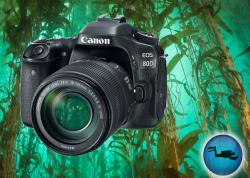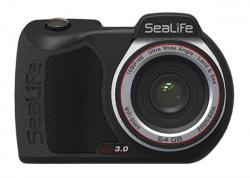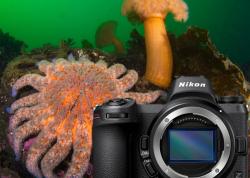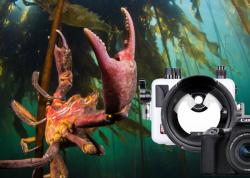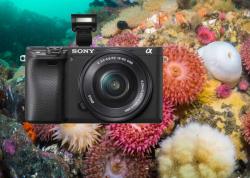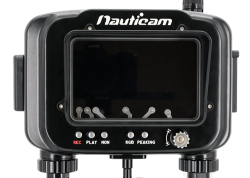Olympus TG-6 Review
Before the review the Olympus TG-6, let's talk about its predecessor. The Olympus TG-5 waterproof camera has been the go-to camera for compact and macro underwater photographers since its release in May, 2017. Two years later, the underwater photographic community has been itching for an upgrade. After all, who doesn’t want an even better version of an already amazing camera? But the May, 2019 release of the Olympus TG-6 and Olympus TG-6 underwater housing has been met with mixed reviews. Overall, the "upgrade" appears to be a firmware update with a few surface changes to the camera and a good PR campaign. So if you have the Olympus TG-5, you may want to wait for the Olympus TG-7 before you upgrade.
***update*** The OM system TG-7 has been released, and you may want to wait for the OM System TG-8 for an upgrade - it's very similar to the Olympus TG-5 and TG-6!
However, this isn't to say the Olympus TG-6 isn't a great camera. It's one of the best compact cameras out there for the price, and the best camera in the Olympus Tough line. And fortunately for underwater photographers, the few upgrades made have been geared towards underwater photography. If you have yet to experience the macro magic of the Olympus Tough compact camera line, it’s time to take a serious look at the Olympus TG-6. The Olympus Tough line of camera is known for an amazing image quality to size ratio, indestructible design, beautiful macro capability, and excellent options for underwater accessories. Underwater photographers and snorkelers alike will be happy to know that the few updates that have been made are mostly geared towards underwater use. So lets get to it….
Status: Available Now!
U.S. MSRP Olympus TG-6: $449.99
U.S. MSRP Olympus TG-6 Housing: $299.99
Bluewater Photo Olympus TG-6 Camera and Housings:
Olympus TG-5 Underwater Housing PT-059
Our Top Olympus TG-6 Underwater Bundles and Packages:
Olympus TG-6 Housing and Strobe Package
Olympus TG-6 Camera and Housing Bundle
Great Value Package for the Olympus TG-6
Jump to a Section
TG-6 Specifications | Key Upgrades | TG-6 Features | Implications for Underwater Photography
Wide Angle | Macro | Video | Underwater Lighting
Tips and Tricks | Underwater Housings | Sample Images | Conclusion
Check out our settings guide for the Olympus TG-6
Olympus TG-6 Camera Specifications
Key Upgrades from the TG-5
• Anti-reflective coating to glass around sensor (reduces flare and ghosting)
• Better LCD: 1.04 million dots compared to 460 K dots on the TG-5
• 4K video with super macro autofocus
• Microscope mode (supermacro autofocus) available in program and aperture priority mode
• Video available in program and aperture priority mode
• Focus stacking and focus bracketing
• More underwater shooting modes/underwater white balance presets (aperture priority still yields best image quality)
Olympus TG-6 Complete Specs
• 12MP 1/2.3" BSI CMOS sensor optimized for low light (4000x3000 image resolution)
• Olympus TruePic VIII image processor
• Waterproof (50ft without housing), shockproof, crushproof, freezeproof
• Fast f/2.0-4.9 lens with 4.5mm - 18mm focal length (equivalent to 25mm - 100mm)
• Sensor-shift image stabilization (up to 2.5 stops)
• Minimum working distance 1cm (in super macro mode)
• ISO range 100 - 12,800
• 25 autofocus points with Single AF and Tracking
• 4K@30p video recording (approx. 102 Mbps bit rate)
• High Speed Movie mode with 1920x1080@120fps / 1280x720@240 fps / 640x360@480fps
• 4K timelapse video
• Pro Capture mode for 20fps image capture
• Shutter speed 4 sec to 1/2000 sec
• Custom white balance (4 slots)
• Built-in flash
• SD storage (SD, SDHC, SDXC)
• RAW and jpeg shooting
• WiFi capabilities, including camera control via smartphone
• Action track sensors record location, temperature, direction and altitude data
• Weight (approx): 250g / 8.72oz with battery & memory card
• Dimensions: 113mm x 66mm x 31.9mm (4.43in x 2.6in x 1.23in)
• Battery life (CIPA): 340
Key Upgrades from the TG-5
Although the Olympus TG-6 has few significant upgrades from the TG-5, there are still some things worth talking about - notably an improved LCD, underwater white balance modes, 4K macro video, and changes to the program and aperture priorirty modes.
Improved LCD Resolution
The resolution of the back LCD screen has been improved significantly - from 460 K dots on the TG-5 to 1.04 million dots on the TG-6. Although this won't result in any changes to your images, it can help make image review an easier affair. Personally, I review images quite a lot when I shoot with the Olympus Tough series underwater. It's essential for making sure I got proper focus and exposure on each shot. So I welcome the change.
Underwater White Balance Modes
Olympus added three underwater white balance modes to the TG-6. For avid underwater photographers and videographers - it's still better to shoot with auto white balance with strobes or a video light. If you're shooting with ambient light, it's still better to bring a slate and shoot with manual white balance. But if you're not a super serious photographer or you're a causal snorkeler/free diver, these modes will be great for easily capturing some color in your images on the fly.
More options while in Aperture Priority and Program Modes
With the Olympus TG-5, you had to move the ring dial to shoot in microscope or video mode. Now supermacro autofocus and video are both available in aperture priority and program modes. This means you don't have to switch to the microscope or video modes! It also means you can now shoot 4K macro video with supermacro autofocus (same as microscope mode).
TG-6 Key Features
Body and Build
The Olympus TG-6 is almost identical to the TG-5 in terms of design. It has the same level of indestructability – freezeproof to 14°F / -10°C, crushproof to 220 lbf / 100 kgf, and shockproof from 7 ft / 2.1 m. The size is the same, and it is compatible with the Olympus TG-5 underwater housing. Likewise, the TG-5 should be compatible with the Olympus TG-6 housing.
It is waterproof to 50 ft, so if you wish to take photos in the range of normal recreational scuba diving depths, it’s recommended to purchase an underwater housing.
The LCD screen now has a much sharper resolution than the TG-5. However, it is still a little scratchable.
The one upgrade to the build that will be beneficial to underwater photographers is the anti-reflective coating to glass around sensor that reduces flare and ghosting. This is great for wide angle photographers that like to shoot into the sun and capture sunballs.
Controls / Ergonomics
The controls and ergonomics on the TG-6 are the most significant improvement from the TG-5. However, it could have all been updated as a firmware update rather than a new model of camera. Regardless, microscope mode and video functions are now available in program and aperture priority modes. This makes it so you can shoot macro, wide, and video without switching modes!
Unfortunately, there still isn’t a manual mode on the camera. The TG-6 does offer additional underwater white balance presets as upgrades to the TG-5, but we still recommend shooting in aperture priority mode with auto white balance and strobes for the best results. The underwater white balance presets are more enticing for snorkeling photography without strobes. The white balance presets are depth based which can be beneficial for free divers that want a small package.
Sensor and Image Quality
The sensor on the Olympus TG-6 is still the same great 1/2.3” BSI CMOS 12 MP sensor. Having shot the TG-5, we can say with confidence that the image quality on the TG-6 is excellent for a compact camera of this size. The lowlight performance is surprisingly good with less noise in the image and faster processing times than the TG-4. If you want beautiful underwater images at an excellent price point, this camera will not disappoint.
Implications for Underwater Photography
Overall, the main upgrade in image quality is going to be the anti-reflective coating around the sensor. This will be welcomed by anyone who shoots regularly into the sun or in situations with high dynamic range.
All other updates in design focus on ergonomics. It’s certainly easier to shoot with macro, video, and wide-angle all being available on one aperture priority mode! So Olympus did, in fact, make an already great camera even better. We just wish there was more!
TG-6 Wide-Angle Shooting
A wide-angle wet lens increases the field of view, which means that for shooting a given subject at a certain size in your photo, you have to be quite a bit closer to it. Although this can be a hassle with a skittish subject, what it does mean is that you get less water between the camera and your subject. And less water means a clearer subject, as well as better lighting from video light, photo light or strobe, which means much better colors. A wider angle also allows for more dramatic shots, especially with large subjects like oil rigs, kelp forests, large animals, reefscapes and wrecks.
We recommend using the UWL-04 fisheye lens, which with its 165 degree wide angle of view will allow you to create stunning wide-angle shots. Other great options to consider are the Kraken KRL-01 and KRL-02 wet wide angle lenses, which provide 145 and 150 degree angles of view, respectively. Olympus also offers a wet wide angle lens, the PTWC-01, which provides a 100 degree angle of view. Note that a step-up ring (52mm > 67mm) is necessary to be able to use the Olympus and Kraken KRL-01 wet lenses with the Olympus TG-6 housing.
TG-6 Macro Shooting
With other compact cameras, the only real way to take great macro photos of small subjects is to use a wet macro lens (also known as a wet diopter). However, with the TG-6's amazing Microscope Mode, macro shooting can be done without using any wet wide angle lens. As mentioned in the above section on Microscope Mode, the TG-6 can focus on a subject only 1 cm away, and by using the optical zoom can get a magnification of 7x without using the added digital zoom capabilities.
If you want to get even more macro functionality, to shoot super-macro, the Bluewater +7 macro lens gives very good results. We recommend stacking 2 of these lenses for supermacro.
Olympus TG-6 Video
The video on the Olympus TG-6 is actually quite spectacular for a camera of its size. Although there is a crop factor and you aren't going to get quite so many details as a camera with a larger sensor, the 4K video is quite good. It is very simple to capture video - all you need is a quick press of a button. We took some stunning footage underwater where the TG-6 handled dynamic range quite well. One of the important updates on the TG-6 for underwater video is the fact that you can now shoot amazing 4K macro video in microscope mode.
Strobes, Flashes and TTL Capability
Strobes are external flashes for use underwater. They help make your photos sharper, and more importantly, restore true colors to marine life. (When lit only by ambient light, subjects lose color through all the water between them and the surface, and between them and your lens). Check out this article about strobes for more information.
Through-the-lens (TTL) is a strobe setting where your camera controls your strobe power based on its own light metering. The internal flash trigger is transmitted to your strobes via fiber optic cables, and your strobes fire with a corresponding strength. You can get optical TTL when using fiber optic cables with the Sea & Sea YS-03 (also see TG-5 package with YS-03), YS-01, YS-D1, and YS-D2 strobes. You can also use the Inon Z240, Z330, S2000, or D2000 strobes. TTL works in all modes - P, A and auto modes.
One notable downside of the TG-6 when using with strobes, is that on max power the internal flash recycle time is about 4 seconds (meaning you will have to wait that long in between taking photos with the strobe). Often the flash should not be firing at max power though, meaning typically less time between shots. There is also an option to turn down the power of the internal flash using the flash compensation function, which will reduce the flash recycle time further, meaning even less down-time between shots.
The Best Option for TTL (auto strobe exposure)
When it comes to getting the right exposure with your underwater strobe, Ikelite goes above and beyond with their RC1 TTL converter. The RC1 TTL converter is a special device that can only be used with Ikelite DS strobes. This device takes the RC flash signal from your Olympus TG-6 and tells the Ikelite DS strobe what exposure you need for your shot. It's extremely accurate and produces great results! We used the RC1 TTL converter in all of our TG-6 sample shots. For the TG-6 we recommend the DS 51 strobes, and if you need a lot of light for wide angle, the DS 160s.
Tips and Tricks: Getting the Most Out of Your TG-6
For more detailed info, be sure to check out our Olympus TG-6 Settings Guide
The Olympus TG-6 is a fool proof camera - it's small, indestructible, and easy to use. Unfortunately this can make it a little less versatile than a higher end compact camera due to a lack of a full manual mode. Don't get me wrong - the TG-6 takes great shots in automatic and aperture priority mode. But sometimes the camera isn't as accurate as one would like in choosing the right aperture (for proper depth of field) or the right shutter speed/ISO (for proper exposure). Fortunately, we have taken the TG-6 underwater and are here to share with you our top tips and tricks for shooting underwater with the Olympus TG-6.....
1. Ikelite RC1 TTL Receiver for DS strobes and Olympus TG-6
Yup, that sounds like a mouthful. But it's actually much easier to use than it sounds. The Ikelite RC1 TTL receiver is only compatible with Ikelite DS strobes (we recommend the Ikelite DS 51 for the Olympus TG6), and Olympus/Panasonic cameras. This device makes it so that your strobes properly expose your photos with every shot. You won't ever have to worry about photos being blown out or too dark. It really is just point and shoot (but you still have control over your settings!). The only other items you need for this to work are your camera, an Olympus TG-6 underwater housing with fiberoptic ports, and fiber optic cables. Normally DS strobes need to be triggered with sync cords but in this case, the fiber optic signal is converted and stil triggers the strobe.
The RC1 TTL receiver will also select smaller apertures in microscope mode which is a huge benefit because it increases the depth of field in your images. So if you're looking for a way to shoot macro, properly expose your images, and get more depth of field - the RC1 TTL receiver is the way to go.
Recommended settings with the RC1 TTL receiver in Microscope Mode:
- Picture mode - natural
- ISO 100
- Auto white balance
- 4:3 aspect ratio
- RAW format
- Still IS ON
- Flash - RC mode
- Exposure comp 0 (adjustable)
- Frame rate - single
- Meter - spot. It's extremely important to pick spot metering, not ESP.
- Face priority - off
- Accessory - off
2. Use the new Super Macro Autofocus option instead of Microscope Mode
Previous renditions of the Olympus Tough line were a little annoying to shoot macro with underwater. Anytime you wanted to switch to macro, you had to turn the mode dial from Aperture Priority or Program mode to Microscope Mode. Now, all you have to do is click "ok" on the camera, selected the Super Macro Autofocus mode and you're ready to shoot macro without turning the mode dial. One less step can be the difference between getting a nice series of photos from different perspectives, and losing your subject because it took to long to switch to macro.
Moreover, microscope mode doesn't let you select your aperture value, so if you want more depth of field in you macro shots - make sure you shoot Aperture priority and use supermacro AF. This allows you to select a smaller aperture for more depth of field!
3. Use the custom menu to set a minimum shutter speed and a maximum ISO in Auto ISO Mode.
If you find that not being able to shoot manual is very frustrating, or if you want proper underwater exposure with your wide angle photos, using the custom menu is a work around to not being able to control shutter speed.
In order to maintain a high shutter speed while shooting wide angle, you will need to be in Auto ISO mode. Then, hit your menu button, go to custom menu "C", and select ISO-Auto set. Then you can set the upper limit of your ISO to 400 and your lower shutter speed limit to whatever you prefer. Any shutter speed from 1/125 to 1/500 should work.
Olympus TG-6 Underwater Housings
There is great news for photographers looking to upgrade to the Olympus TG-6 - it is compatable with the Olympus TG-5 underwater housings! That being said, many Olympus TG-6 housing are available as well!
Below are some great housing choices from our sister company, Bluewater Photo. Check out the housings and be sure to reach out for the best recommendations on accessories like macro and wide-angle lenses, lights and strobes.
Olympus PT-059 TG-6 Housing
The Olympus underwater housing for the Olympus TG-6 is compact and lightweight, with great ergonomics. It is rated to a depth of 45m (147 ft), and all camera controls can be accessed from the housing with ease. It can accept a variety of wet lenses for both wide angle and macro shooting, and most importantly, it is very affordable!
.
Purchase the Olympus TG-6 housing
 Ikelite TG-6 Housing
Ikelite TG-6 Housing
Ikelite housings are made from an ABS polycarbonate blend, making it both lightweight and strong. This durable housing is rates for depths of 60m (200 ft). It features a side-mounted shutter release and a new zoom control, for easy operation. The housing port has a 67mm thread, making it compatible with multiple wet lens options, both wide angle and macro. Along with the Olympus housing, this is the most affordable TG-6 housing available. We highly recommend using this housing with Ikelite DS strobes and the Ikelite RC1 TTL converter for the best exposure and easiest functionality from your TG-6.
Purchase the Ikelite TG-6 housing

Nauticam TG-6 Housing
The Nauticam TG-6 housing, constructed from milled aluminum, was designed with a focus on ergonomics. It offers features found in their high end DSLR housings.
- All controls are clearly labeled, with an easy-to-identify bright red video recording button.
- The patented rotary lock system is used, facilitating easy opening and closing, while still providing a secure latch system that will not accidentally be disengaged
- Sculpted thumb grip and shutter lever make it comfortable to hold and use underwater
- Depth rating of 100m (330 ft)
The housing includes a 52mm threaded port, allowing addition of different wet lenses (macro and wide angle) to expand your underwater shooting ability. In addition both a cold shoe and M10 mount offer multiple mounting points for additional accessories. Dual Fiber Optic Connections are included, with holes that fit the standard Sea & Sea style plug or bare ended fiber optic cables.
Purchase the Nauticam TG-6 housing
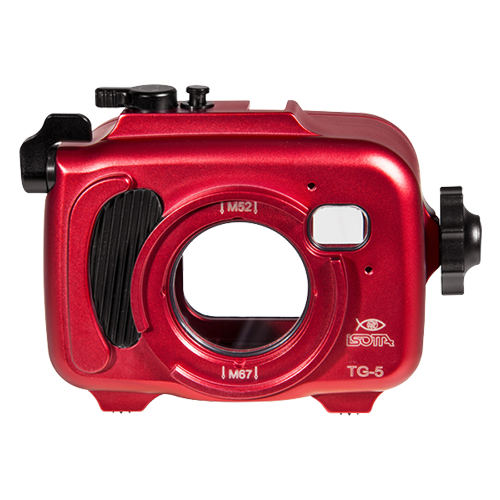
Isotta TG-6 Housing
Isotta offers a top notch housing for the Olympus TG-5 and TG-6. The housing is made from high-quality thermo-coated & anticordal aluminum. It includes a back window to take advantage of the TG-6's high resolution LCD, and a flatport with an M67 thread for wet lenses. The housing also features
- One handed open/close lock system
- Double O-Ring seal for extra protection
- Ergonomic button and lever placement with laser-engraved controls
- Double lens threading for both 52mm and 67mm wet macro lens. This means no step-up rings required!
Purchase the Isotta TG-6 housing
Olympus TG-6 Sample Images
After so many dives we just had too many wonderful images with the Olympus TG-6 not to share!
Conclusion
Despite relatively few updates, the Olympus TG-6 is is still a great option in the budget compact camera world. If you already own the TG-5, this may not be the upgrade of your dreams. In fact, since it's cheaper to buy the TG-5, this might now be the best option in the Tough line. However, if you are an avid snorkeler and diver and looking for a great compact camera, definitely consider the Olympus TG-6.
![]()
Bluewater Photo Olympus TG-6 Packages:
Olympus TG-5 Underwater Housing PT-059
Additional Reading
RECOMMENDED ARTICLES
SUPPORT THE UNDERWATER PHOTOGRAPHY GUIDE:
The Best Service & Prices on u/w Photo Gear
 Visit Bluewater Photo & Video for all your underwater photography and video gear. Click, or call the team at (310) 633-5052 for expert advice!
Visit Bluewater Photo & Video for all your underwater photography and video gear. Click, or call the team at (310) 633-5052 for expert advice!
The Best Pricing, Service & Expert Advice to Book your Dive Trips
 Bluewater Travel is your full-service scuba travel agency. Let our expert advisers plan and book your next dive vacation. Run by divers, for divers.
Bluewater Travel is your full-service scuba travel agency. Let our expert advisers plan and book your next dive vacation. Run by divers, for divers.



















